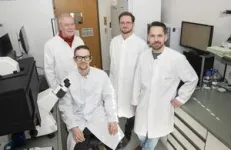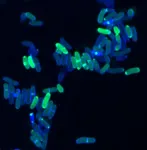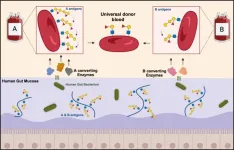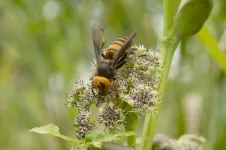(Press-News.org) The Tibetan plateau—the world’s highest and largest plateau—poses a challenge to the people who live there because of its extreme climate. In a new study, researchers have discovered stone artifacts that suggest that there were more cultural exchanges between those who lived on the plateau and those living on its perimeter.
“The Tibetan plateau has an average elevation of more than 4500 meters, which makes Colorado seem like it is at sea level. It’s amazing that people have been able to occupy this area on and off for at least the last 40,000 years,” said Stanley Ambrose (MME), a professor of anthropology. “Unfortunately, very little research has been done in this big area.”
The plateau covers roughly four times the size of Texas and the researchers were focused on the Holocene period, which began about 11,700 years ago. “Although the world was warmer and wetter, this high-altitude location was arid and largely grassy, making it a challenging place to live in.”
The researchers focused on a region of the plateau that supported a small human population due to its cold, dry climate and reduced oxygen levels. However, this area was prime grazing territory for yaks and gazelles. Previously it was believed that the residents developed unique strategies to survive, including making specialized stone tools and having unique genetic adaptations that helped them adapt to low oxygen conditions.
“These tools were ideal because they could be reconfigured easily for different purposes. They were flexible and versatile, allowing the owners to carry a bag of bladelets that could be then shaped within seconds,” Ambrose said. “Before that, everybody was running around with big knives and spears, which were durable and strong, but weren’t diverse.”
In the present study, the researchers excavated over 700 artifacts by digging through the surface and collecting them from different sedimentary layers. They then dated these tools using Accelerator Mass Spectrometry 14C to confirm their age and composition.
The researchers confirmed that the blades were from the middle-to-late Holocene. Intriguingly, they also discovered that the blades themselves were similar to the ones that had been developed in northern China, suggesting that there was a long-distance cultural exchange between the Tibetan plateau and northern China through the communities that lived on the plateau’s perimeter.
“These artifacts were created from geological materials that were located hundreds of kilometers away, suggesting that there were large social networks that were much bigger than the largest human hunter-gatherer ranges,” Ambrose said. “It also implies that these networks had long-distance interaction and communication.”
The researchers are now interested in expanding the size of the excavations to prove their hypothesis. “Although this is a very small excavation, there is enough to show that there were long-distance interactions. Now we need to look at larger areas and get more samples to see if we can go further back in time,” Ambrose said.
The study “The earliest microblade site 6800 years ago reveals broader social dimension than previous thought at the central high altitude Tibetan plateau” was published in Quaternary Science Reviews and can be found at https://doi.org/10.1016/j.quascirev.2024.108551. It was funded by the National Natural Science Foundation of China, the Fund of Shandong Province, and the Second Tibetan Plateau Scientific Expedition and Research program.
END
Tibetan plateau had broader social dimensions than previously thought
2024-04-29
ELSE PRESS RELEASES FROM THIS DATE:
Oncotarget sponsors 19th International p53 Workshop in Italy
2024-04-29
Oncotarget is a contributing sponsor at the 19th International p53 Workshop in Trieste, Italy, on May 13–16, 2024.
BUFFALO, NY- April 29, 2024 – Oncotarget is a contributing sponsor at the 19th International p53 Workshop, organized by the International Center for Genetic Engineering and Biotechnology (ICGEB), which takes place from May 13–16, 2024, in Trieste, Italy.
“Groundbreaking research and cutting-edge advancements in the field of the most studied human gene and most frequently mutated gene in cancer, will take center stage at the 19th ...
NYS solar work: Good for climate, but are they good jobs?
2024-04-29
ITHACA, N.Y. -- New York state solar construction workers – whose numbers are expected to grow rapidly to meet climate goals – are transient, may not receive benefits and are subject to racial disparities in pay, finds a new report from the Climate Jobs Institute (CJI) at Cornell University.
“Exploring the Conditions of the New York Solar Workforce” was funded by the New York State Department of Labor and surveyed more than 260 solar installation and maintenance workers. The exploratory study is the first to focus on workers’ experiences, seeking to bridge gaps in government and industry ...
New system boosts efficiency of quantum error correction
2024-04-29
The fragile qubits that make up quantum computers offer a powerful computational tool, yet also present a conundrum: How can engineers create practical, workable quantum systems out of bits that are so easily disturbed — and wiped of data — by tiny changes in their environment?
Engineers have long struggled with how to make quantum computers less error-prone, often by developing ways to detect and correct errors rather than prevent them in the first place. However, many such error-correction schemes involve duplicating information across hundreds or thousands of physical qubits at once, which quickly becomes hard to scale up in an efficient way.
Now, ...
Study suggests staying current with COVID-19 vaccinations helps combat emerging variants
2024-04-29
New research using live SARS-CoV-2 virus reveals an updated vaccine provides a strong immune response against previous strains and emerging variants.
The findings by researchers at Oregon Health & Science University, published in the journal Emerging Infectious Diseases, suggest a clear benefit in receiving updated vaccinations on a regular basis, especially among older people or those with underlying medical conditions.
“The virus is still circulating, it’s continuing to evolve, and it remains dangerous,” said co-senior author Fikadu Tafesse, Ph.D., associate professor of molecular ...
It’s all in the smile: Aston University-led research finds politicians can influence voters with facial expressions
2024-04-29
Dr Carl Senior identified two types of smile – affiliative and reward – given by political leaders during the last UK general election in 2019
The eventual winner, Boris Johnson, was found to display the affiliative smile, which acts to align voter behaviour
The study is the first to look at how supporters of election losers react to the eventual winner.
New research led by Aston University’s Dr Carl Senior has found that the type of smile used by a political leader can influence voters to support them and their political agenda.
There are many different types of smile, and the ...
Possible alternative to antibiotics produced by bacteria
2024-04-29
Many bacteria produce substances to gain an advantage over competitors in their highly competitive natural environment. Researchers at the University Hospital Bonn (UKB), the University of Bonn and the German Center for Infection Research (DZIF) have discovered a new so-called lantibiotic, namely epilancin A37. It is produced by staphylococci that colonize the skin and acts specifically against their main competitors there, the corynebacteria. This specificity is presumably mediated by a very special mechanism of action, which the researchers were able to decipher in detail. ...
Quantitative study assesses how gender and race impact young athletes’ perceptions of their coaches
2024-04-29
Quantitative study assesses how gender and race impact young athletes’ perceptions of their coaches
Across the U.S., there are over 8 million student-athletes in high school and college. Engaging in sports can contribute to physical, mental, and social benefits, and coaches can play a key role in student-athletes’ continued participation in sports.
A recent study led by UNC Greensboro’s Dr. Tsz Lun (Alan) Chu, published in Sport, Exercise, and Performance Psychology, examines how multiple aspects of a young athlete’s ...
Enzymes open new path to universal donor blood
2024-04-29
The quest to develop universal donor blood has taken a decisive step forward. Researchers at DTU and Lund University have discovered enzymes that, when mixed with red blood cells, are able to remove specific sugars that make up the A and B antigens in the human ABO blood groups. The results have been published in the scientific journal Nature Microbiology.
"For the first time, the new enzyme cocktails not only remove the well-described A and B antigens, but also extended variants previously not recognized as problematic for transfusion safety. We are close to being able to produce universal blood from group B donors, while there is still work to be done to convert ...
Gemini south reveals origin of unexpected differences in giant binary stars
2024-04-29
It is estimated that up to 85% of stars exist in binary star systems, some even in systems with three or more stars. These stellar pairs are born together out of the same molecular cloud from a shared abundance of chemical building blocks, so astronomers would expect to find that they have nearly identical compositions and planetary systems. However, for many binaries that isn’t the case. While some proposed explanations attribute these dissimilarities to events occurring after the stars evolved, a team of astronomers have confirmed for the first time that they can actually originate ...
Hornets found to be primary pollinators of two Angelica species
2024-04-29
Researcher Ko Mochizuki of the University of Tokyo discovered that two species in the genus Angelica are pollinated primarily by hornets. This overturns the conventional belief that Angelica species are “generalists,” meaning that there is not one primary pollinator but a variety of species. As hornets are rarely primary pollinators, the discovery also impacts future ecological research and conservation efforts. The findings were published in the journal Ecology.
White, small, open, secretes nectar and produces pollen: these are the kinds of flowers that many types of insects can reach ...







